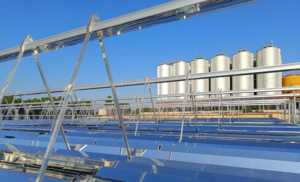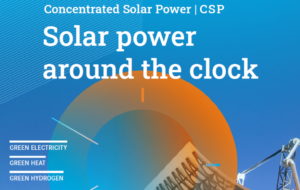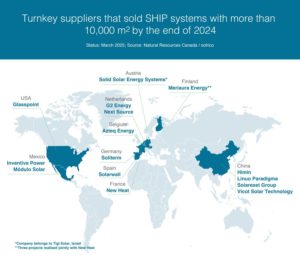Parabolic trough collector field as part of 100 % carbon-free heat supply for food factory in Australia
November 19, 2024
Site work has started on what will be the largest concentrating solar heat project in the Australian food industry. An 18 MW parabolic trough field is to be built at the Mars Petcare facility in Wodonga in the state of Victoria. The EPC for the solar field is the Belgian company Azteq supported by the engineering capacity of its German subsidiary Solarlite. The system is expected to begin operations in the second quarter of 2026. The solar process heat installation is part of Mars Petcare’s decarbonization strategy, which aims at being carbon neutral within two years. The AUD 39 million project will be backed by more than AUD 17 million in funding from the Australian Renewable Energy Agency (ARENA). The photo shows Paul Matuschka, the Sustainability Manager at Mars Petcare, introducing the solar process heat installation during a webinar organized by the Australian Alliance for Energy Productivity (A2EP) on 13th November 2024.
Source: https://www.a2ep.org.au/post/webinar-13-november-solar-heat-for-industrial-processes-australian-opportunities
“There is a portfolio of solutions to achieve 100 % renewable energy solution for our factory in Wodonga and concentrating solar heat is one of them. We target 50 % replacement of natural gas with the solar field together with the steam accumulators that we are planning to put in”, explained Matuschka during the webinar. Under the title Solar heat for industrial processes: Australian opportunities three presenters talked about national and international development and economics of solar process heat. The recording and the presentations are available online.
Mars Petcare is a leading provider of nutrition and therapeutic health products in Australia. It has already been producing in the Wodonga area for more than 50 years.
Special features of the high-temperature solar heat plant at Mars
In addition to its size, which is unusually large for Australia so far, two other features of this plant are noteworthy. Firstly, the steam is generated directly. This means that the solar circuit is operated with water and the water is vaporized directly in the receiver tubes to produce saturated steam, which is then separated into steam and water before the storage tanks. In previously installed parabolic trough systems from Azteq in Europe, thermal oil is used as the heat transfer medium, which then produces steam in a downstream steam generator.
The second special feature is that the system is operated by the customer itself and was tendered for and awarded in three separate areas: collector field, storage tank and balance of plant. The trend is different in Europe. Recently, heat purchase agreements have always been concluded for larger solar process heat plants there.
Matuschka confirms that the Chinese company Livo won the tender for the steam accumulators and that Mars is supported by the Australian company Gasco for the balance of plant. He explained during the webinar why Mars has not signed a heat purchase agreement. “We are a first mover with this size of installation in Australia and as such, we didn’f find a cost-competitive heat purchase agreement in this space, at this time.”
Therefore, the large investment grant from ARENA was an important contribution to the project. The grant of AUS 17 million was officially announced at a ground-breaking ceremony on 29th October at the Wodonga factory, which was even joined by Prime Minister Anthony Albanese. The funding was provided within the Advancing Renewables Program. The programme is continuously open for low-emissions projects and activities that involve a renewable energy technology.
100 % decarbonization heat strategy of Mars
“We are incredibly proud to announce that Mars will be the first manufacturing facility of its kind in Australia to deploy a 100 % renewable energy solution within two years,” Craig Sargeant, General Manager of Mars Petcare Australia and New Zealand, is quoted as saying in a press release sent out by the company on 29th October.
In addition to the parabolic trough field, the decarbonization path for the heat demand of the Wodonga site comprises two further components. According to Matuschka 25 to 30 % of the heat will be provided by a high-temperature storage unit from the Australian company Graphite Energy via power to heat. The solid-state storage tank allows the facility to utilize low-cost, grid-connected renewable electricity during off-peak times to generate and store heat that can produce steam at any time of day or night. The prerequisite here is that Mars already concluded a 100 % renewable electricity purchase agreement for its six Australian factories and two offices in 2021. The remaining 20 % will be covered by a purchase agreement for renewable gas guarantee of origin certificates generated by the new hydrogen park Murray Valley facility being built in Wodonga.
| Site | Wodonga, state of Victoria, Australia |
| Investor and operator of concentrating solar heat plant | Mars Petcare, Australia |
| Collector type | Parabolic trough collectors with a trough width of 5.77 m |
| Thermal capacity of solar heat plant | 18 MWth |
| Collector aperture area | 28,000 m2 |
| EPC for solar collector field | Azteq, Belgium |
| Engineering of solar collector field | Solarlite, subsidiary of Azteq, Germany |
| Temperature of solar steam provided to factory | 245 °C |
| Steam storage capacity | 150 MWh |
| Predicted annual production output | 26.4 GWh per year |
| Specific solar yield | 943 kWh/m2 per year |
| Total investment for collector field including storage tank | AUD 39 million / 25.2 million USD |
| Specific investment costs of solar field including storage | 900 USD/m2 aperture area |
| Subsidy from Australian Renewable Energy Agency | AUD 17 million |
| Planned start of construction of the collector field | Beginning of 2025 |
| Planned regular operation | 2nd quarter of 2026 |
Key features of the parabolic trough collector field for Mars Petcare. Source: Mars Petcare
New funding opportunities for solar process heat in Australia
ARENA has started the Industrial Transformation Stream (ITS) Program. Between November 2023 and December 2024, the agency allocated an AUD 150 million budget for applications in two focus areas:
- Supporting the decarbonization of process heat used in industrial processes;
- Off-road transport decarbonization.
On the programme’s website it says: The program will support projects ranging from studies to demonstrations and deployment. Opportunities may address a wide range of solutions, including energy efficiency, electrification, and any renewable energy technologies that support industrial decarbonization (e.g. switching to renewable fuels, solar thermal systems or zero-emission vehicles). Enabling technologies such as energy storage or load flexibility / demand management and critical infrastructure to support on-site industrial decarbonization will also be considered.
Websites of organizations mentioned in this news article:
Mars Petcare: https://www.mars.com/
Australian Alliance for Energy Productivity: https://www.a2ep.org.au/
Azteq: https://azteq.be/
Solarlite: https://www.solarlite.de/en/
Gasco: https://www.gasco.net.au/
Industrial Transformation Stream Program: https://arena.gov.au/funding/powering-the-regions-industrial-transformation-stream/


